Fenghuang Ancient Town, situated in the southwest of Xiangxi Tujia and Miao Autonomous Prefecture in Hunan Province, is rich in history and cultural heritage. It was founded in the Tang Dynasty, flourished during the Ming and Qing dynasties, and boasts a history spanning over 1,300 years, making it a place filled with mystique. The town covers an area of approximately 10 square kilometers, nestled amidst mountains and rivers. It is a typical ethnic minority settlement composed of 28 ethnic groups, including the Miao and Tujia.
The ancient town is renowned for its unique architectural style. Many of the buildings here adopt a wooden structure, with stone walls and tiled roofs. Additionally, it boasts numerous ancient streets, alleys, and dwellings, all of which are witnesses to its rich history and culture.
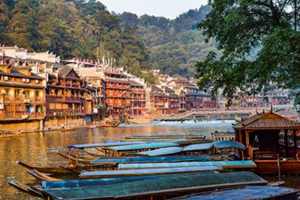 Fenghuang Ancient Town
Fenghuang Ancient Town
Within Fenghuang Ancient Town, there are numerous scenic spots worthy of a visit, such as the Former Residence of Shen Congwen, the Ancient Town Museum, the Longevity Palace, and the East Gate Tower. Shen Congwen's Former Residence is an important venue to understand the history and culture of Fenghuang, while the Ancient Town Museum is a comprehensive museum integrating Fenghuang's historical culture, folk culture and artistic culture. Furthermore, rowing on the Tuojiang River is also a favorite activity for tourists, where you can take a boat to admire the scenery along both sides of the river, experiencing the harmonious coexistence of the ancient town and nature.
Here, you can not only stroll along the riverbank and immerse yourself in the attracting night view of the ancient town, but also experience the unique local folk culture. Whether you are a history enthusiast or a tourist who enjoys experiencing different cultures, this is a place worth visiting.
Highlights You Can't Miss
Stilted Building Group (Diaojiaolou)
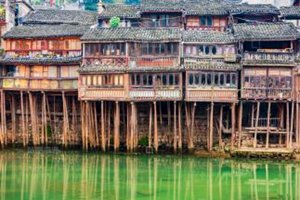 Stilted Building Group (Diaojiaolou)
Stilted Building Group (Diaojiaolou)
In Fenghuang Ancient Town, the most distinctive architecture is undoubtedly the quaint and elegant stilted buildings. The formation of these buildings is closely related to their historical background. The monarchs of various dynasties implemented policies of suppressing the Tujia and other ethnic groups, forcing them into remote mountainous areas with extremely harsh living conditions. Under such circumstances, the Tujia people began to construct stilted buildings on cliffy slopes in order to adapt to the unique topography and climate of the mountainous regions. In the early days, the chieftain had restrictions on the building materials used by the Tujia people, allowing only the use of cedar bark and thatch as roofing materials. It was until the Qing Dynasty that they began to use tiles as roofing materials.
Stilted buildings are often built along mountains and rivers, with particular attention paid to their orientation. The main house is constructed on solid ground, while the side rooms, except for one side that connects to the ground, are suspended on all three other sides, supported by pillars. This design not only ensures ventilation and dryness, but also prevents the intrusion of venomous snakes and wild animals. The construction of stilted buildings is also a significant event in the life of the Tujia people. From preparing the timber, processing the main beams and pillar materials, to building the house, every step is filled with a sense of ritual and local flavor.
The stilted buildings, resembling phoenixes spreading their wings ready to take flight, quietly stand by the banks of the Tuojiang River. Here, you can sense the traces of time and hear the echoes of history. Every plank and beam of the stilted buildings seems to narrate the past glory and vicissitudes. They are not only the iconic architecture of Fenghuang Ancient Town, but also an important carrier of Xiangxi culture. These buildings have witnessed the rise and fall of this town, carrying the memories and emotion of countless people. Under the shelter of the stilted buildings, people have lived a peaceful and serene life, leaving behind many beautiful legends and stories.
East Gate Tower
The East Gate Tower, constructed during the Ming and Qing dynasties, has endured centuries of trials and tribulations, witnessing the prosperity and transformations of Fenghuang Ancient Town. As the eastern gateway of the town, it serves not only as an essential defensive facility but also as a crucial passageway connecting the inside and outside of the town.
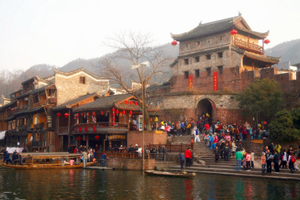 East Gate Tower
East Gate Tower
The East Gate Tower adopts the traditional pavilion-style architecture, with a wide and tall gate that allows carriages and horses to pass through. The gate tower is adorned with carvings depicting auspicious patterns and exquisite natural landscapes such as mountains, rivers, flowers, and birds. These carvings not only reflect the superb skills of the ancient craftsmen, but also embody people's aspirations and pursuits for a better life.
Standing on the East Gate Tower, you can enjoy a panoramic view of the ancient town and the beautiful scenery along Tuojiang River. In the early morning, when the sun's rays cast on the gate tower, it seems to cloak the ancient town in a golden mantle. At dusk, the afterglow shines on the Tuojiang River, reflecting against the East Gate Tower, creating a beautiful picture. Here, you can feel the rich historical and cultural heritage of the ancient town, appreciating the wisdom and creativity of the ancient people.
Former Residence of Shen Congwen
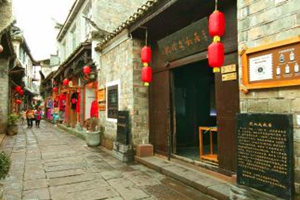 Former Residence of Shen Congwen
Former Residence of Shen Congwen
The Former Residence of Shen Congwen is the birthplace of the renowned Chinese writer. Constructed during the Qing Dynasty, it exemplifies the classic quadrangle courtyard style of the south. This wooden-structured courtyard is delicately designed, exuding an antique and elegant ambiance. Inside, you can find displays of Shen Congwen's life photos, handwritten manuscripts, book editions, and even daily items he used, such as sandalwood tables and rattan armchairs. Here, you can get a close sense of the literary giant's lifestyle and spirit.
It is not only an important cultural heritage of Fenghuang Ancient Town, but also a nationally protected historical and cultural site. Nowadays, the residence is open to the public, allowing visitors to tour and gain a deeper understanding of Shen Congwen's literary achievements and life experiences. It is not just a tourist attraction; it is a literary palace that attracts countless literature enthusiasts and tourists to come and admire.
Former Residence of Xiong Xiling
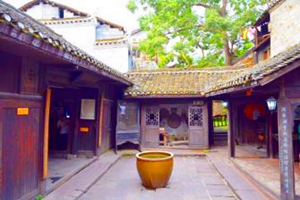 Former Residence of Xiong Xiling
Former Residence of Xiong Xiling
The Former Residence of Xiong Xiling, a renowned politician, educator, and philanthropist in modern China, is the birthplace of the esteemed individual. This residence embodies the rich life experiences and outstanding achievements of Mr. Xiong Xiling. Built in the late Qing Dynasty, this building adopts the typical southern quadrangle courtyard structure, boasting exquisite layouts. Inside the compound, you can find displays of Xiong Xiling's life photos, handwritten manuscripts, and personal items he used, such as desks and chairs. These exhibits allow visitors to intimately experience the living environment and ideological spirit of this great figure.
Mr. Xiong Xiling was an influential figure in the history of the Republic of China. He served as the Premier of the State Council and devoted himself to promoting China's education, charity, and social reform. He founded charitable institutions such as the Xiangshan Children's Home, providing educational and living assistance to orphans and impoverished children, earning widespread praise from society. Here, you can learn about Mr. Xiong Xiling's life and achievements, and feel his profound patriotism and noble ideological qualities.
Yang's Family Ancestral Hall
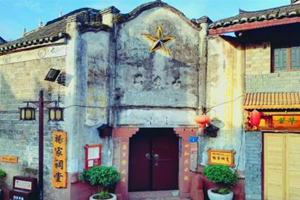 Yang's Family Ancestral Hall
Yang's Family Ancestral Hall
The Yang's Family Ancestral Hall, located near the city wall in the northeastern part of the ancient city, was funded and built by the renowned Qing Dynasty general Yang Fang, boasting a history of nearly two centuries. Occupying a vast area, the ancestral hall exudes an ancient and elegant architectural style. The plaques and couplets within the hall are beautifully decorated, embodying the artistic style of the Ming and Qing dynasties and showcasing the exquisite craftsmanship of ancient architecture.
Not only is it a place for honoring ancestors, but it also serves as an important venue for the Yang’s family to gather and discuss important affairs. As one of the significant cultural relics of Fenghuang Ancient Town, this Ancestral Hall has witnessed the rise and fall of the ancient town for centuries, providing a crucial place for studying the family culture and folk customs in the western Hunan region.
Fenghuang Ancient Town Museum
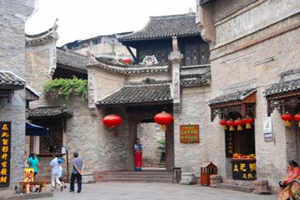 Fenghuang Ancient Town Museum
Fenghuang Ancient Town Museum
This Museum is not only a retrospective of the history of Fenghuang Ancient Town, but also a showcase of the local diverse cultures. Inside the museum, from pottery of the Neolithic Age to jade and bronze ware of the Ming and Qing dynasties, each artifact tells the story of the town's millennium-long vicissitudes and changes. There are also dedicated exhibition areas for the former residences of celebrities and souvenirs, allowing visitors to gain a deeper understanding of the life stories and cultural contributions of figures like Shen Congwen and others.
The Ethnic Culture Exhibition Area showcases the rich traditions of ethnic minorities in the Fenghuang region, such as the Miao and Tujia, through their costumes, musical instruments, and daily necessities, all exuding a strong ethnic flavor. Additionally, the museum introduces the traditional architectural styles and craftsmanship of Fenghuang Ancient Town, including the unique Diaojiaolou (stilted buildings).
Moreover, the Museum boasts an Art and Literature Exhibition Area, which displays diverse artistic and literary works of Fenghuang Ancient Town, reflecting the profound artistic heritage of the region. Notably, Mr. Lei Yutian, the curator of the museum, is also a folk collector and artist, and his works are also showcased here.
Longevity Palace
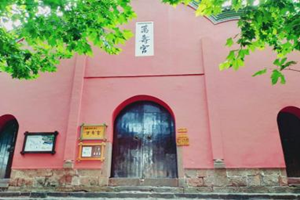 Longevity Palace
Longevity Palace
Longevity Palace, also known as the Jiangxi Guild Hall, was built by Jiangxi merchants who were engaged in business in Fenghuang during the late Ming and early Qing dynasties. The palace covers an area of over 4,000 square meters, with more than 20 elaborately designed and intricately carved buildings and houses standing within.
During the founding of the People's Republic of China, this Palace served as a banknote printing factory, textile mill, primary school, grain store, and more, bearing witness to the changes of the times. Since 2017, the "Fenghuang Art Annual Exhibition" has been hosted here, providing a platform for artists to showcase their talents and attracting countless people to create and exchange ideas. Inside the palace, there is also the Fenghuang Art Gallery, which displays exquisite paintings depicting the scenery of Fenghuang Ancient Town or rural farming life, allowing you to appreciate the charm of art.
Boat Cruise on the Tuojiang River
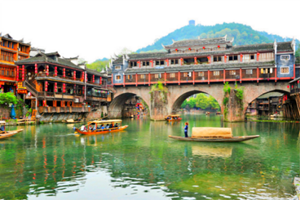 Boat Cruise on the Tuojiang River
Boat Cruise on the Tuojiang River
Tuojiang River, the mother river of Fenghuang Ancient Town, originates from the lofty Jiuding Mountain with an altitude of 4,984 meters. Stretching over 460 kilometers, it traverses mountains and ridges. The starting point for boat cruise on the Tuojiang River is usually set at the pier by the north gate of the ancient Town. Embarking from here, you can enjoy the scenery along both banks of the river. The water is clear and green, with verdant aquatic plants swaying gracefully in the water, dancing to the rhythm of the river. Sitting in a dark-awning boat, drifting slowly along the Tuojiang River, you can also experience the joy of rowing, leaving you with unforgettable memories.
Travel Information
Location: Tuojiang Town, Fenghuang County, Tujia-Miao Autonomous Prefecture of Xiangxi, Hunan Province
Open hours: all day long
Recommended visiting hours: 1-2 days
Admission: Free of Charge
>>>Main Paid Attractions and their Opening Hours in Town:
Eight Scenic Spots (8:00am -- 18:00pm)
Shen Congwen's Former Residence, Xiong Xiling's Former Residence, East Gate Tower, Hongqiao Bridge, Yang Family Memorial Temple, Ancient City Museum, Longevity Palace, Chongde Hall
Tuojiang River Boat Trip (8:00am -- 23:00pm)
Ticket Prices:
Eight Scenic Spots: RMB 98
Tuojiang River Day Trip: RMB 85
Tuojiang River Night Trip: RMB 128
Eight Scenic Spots + Tuojiang River Day Trip: RMB 128
Eight Scenic Spots + Tuojiang River Night Trip: RMB 168
In addition, you can also watch performances and other activities. Please check the official website for more information.
Note: The above information is for reference only. The specific prices and preferential policies may be adjusted according to the season, holidays and other factors, we recommend tourists to check the latest information through official channels before travel.
How to get to Fenghuang Ancient Town
>>>From Changsha:
High-Speed Rail:
Changsha South Railway Station - Fenghuang Ancient Town Station
RMB 194.5; 2.5 Hours
Direct Shuttle to Fenghuang:
Changsha-Zhuzhou-Xiangtan Coach Terminal - Fenghuang
RMB 158; 6 Hours
>>>From Zhangjiajie:
High-Speed Rail:
Zhangjiajie West Railway Station - Fenghuang Ancient Town Station
RMB 93; 1 Hour
Coach:
Zhangjiajie Central Bus Station - Fenghuang
RMB 100; 6 Hours
>>>Airports near Fenghuang Ancient Town:
(1) Tongren Fenghuang Airport
Location: The intersection of Daxing High-tech Zone, Tongren City, Guizhou Province, and Fenghuang County, Xiangxi Tujia and Miao Autonomous Prefecture, Hunan Province.
Distance: 20 kilometers from Tongren City and about 30 kilometers from Fenghuang Ancient Town.
Flight Information: Routes have been opened to Guiyang, Beijing, Shanghai, Guangzhou, Kunming, Shenzhen, Hangzhou, Changsha, Xiamen, and other cities.
Way to Fenghuang Ancient Town: Take a bus from the airport to Tongren Bus Terminal and then transfer to a direct bus to Fenghuang.
(2) Zhangjiajie Hehua Airport
Location: Hehua Village, Yongding District, Zhangjiajie City, Hunan Province.
Distance: About 200 kilometers from Fenghuang Ancient Town.
Flight Information: There are fewer discounted tickets, and most flights are in the evening.
Way to Fenghuang Ancient Town: It takes about four to five hours to arrive, suitable for tourists planning to visit Fenghuang and Zhangjiajie together.
(3) Huaihua Zhijiang Airport
Location: 248 Yingfeng West Road, Zhijiang Dong Autonomous County, Huaihua City, Hunan Province.
Distance: About 140 kilometers from Fenghuang Ancient Town.
Flight Information: There are fewer domestic flights, but the airport is convenient for transportation.
Way to Fenghuang Ancient Town: It can be reached by taxi or bus.
The above are the main airports near Fenghuang Ancient Town. You can choose suitable airports as transfer stations according to your own itineraries and flight information. Please note that the airport distances and transportation methods may change over time. It is recommended to query the latest information in advance.




































